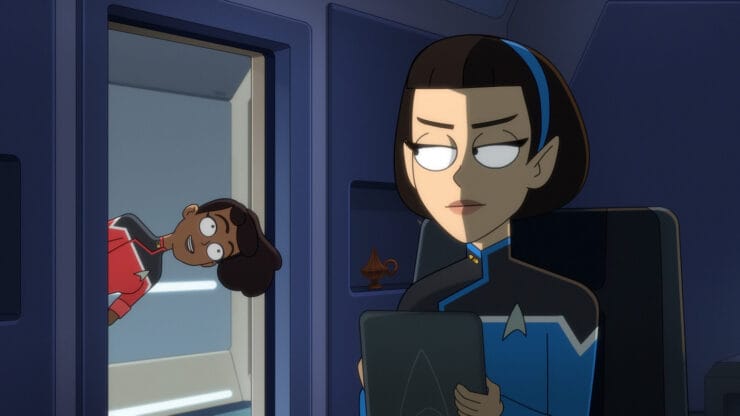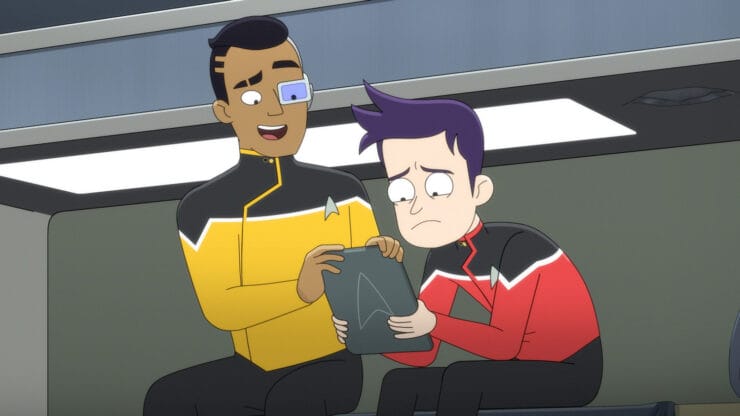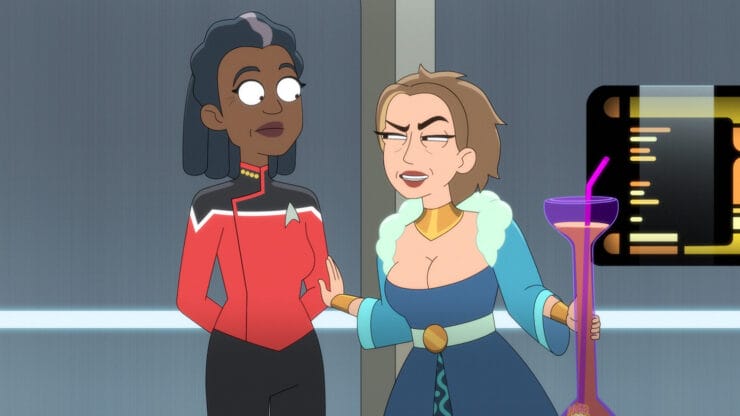Telepathy has been part of the tapestry of Star Trek since the very beginning. Both pilots for the original series, “The Cage” and “Where No Man Has Gone Before,” had telepathy at the heart of their plots. For the former, it was the illusion-casting Talosians; in the latter, it was the great barrier heightening the psychic abilities of crewmembers with “high ESP ratings.” (Ah, the 1960s.) It was later established in “Dagger of the Mind” that Vulcans were touch telepaths.
Over the years, Trek has introduced numerous telepathic species (Medusans, Ullians, Cairn, Letheans, etc.). Series regulars Spock (the original series, SNW), Troi (TNG), Kes and Tuvok (Voyager), T’Pol (Enterprise), and Zero (Prodigy) are all telepaths. So an episode like “Empathalogical Fallacies,” which crosses the streams of having both Betazoid and Vulcan telepathy driving the plot, was inevitable…
The episode primarily focuses on T’Lyn, who has proven to be an immensely valuable addition to the cast. Gabrielle Ruiz’s deadpan has proven to meld (sorry) perfectly with the generally very manic cast of LD to create comedy gold. We’ve already had her team up with Tendi (“Twovix”) and Boimler (“In the Cradle of Vexilon”), and she’s also been part of a group trip (“Something Borrowed, Something Green”), and this week she teams up with Mariner.
In addition we have three Betazoids coming on board. The trio come across as younger, drunker versions of Majel Barrett’s Lwaxana Troi: hedonistic, bombastic, flirty. Brilliantly voiced by Rachel Dratch, Janelle James, and Wendie Malick, their presence on board seems to turn everyone into emotionally crazy people—even more so than usual. The Cerritos quickly turns into a party ship, with crazed celebrating going on all over the ship.
We’ve seen this before with Betazoids, specifically with Lwaxana: in DS9’s “Fascination,” she was suffering Zanthi Fever and telepathically affecting the Deep Space 9 crew, making them act rather batshit. And that’s the assumption that Freeman and T’Lyn both make: that at least one of the Betazoid trio are suffering from Zanthi. However, T’Ana’s examination reveals no trace of the fever.
However, we’ve seen this type of telepathic influence once before: on TNG’s “Sarek,” where Mark Lenard’s titular character was suffering Bendii Syndrome and also telepathically mucking with the Enterprise-D crew.
One of the great frustrations with Trek is that oftentimes something will be introduced in one episode and then never referenced ever again, even though its existence might be useful in other situations. For example, being able to give someone the Platonians’ psychic powers temporarily, as seen in the original series’ “Plato’s Stepchildren,” or La Forge’s PTSD from being mentally manipulated in TNG’s “The Mind’s Eye,” which is never even referenced again, or the EMH’s ability to have a backup program after never being able to be backed up before in Voyager’s “Living Witness,” or the magic healing blood that should’ve revolutionized twenty-third-century medicine in Star Trek Into Darkness.
Another great frustration is the occasional repetition of plot, whether deliberate (TNG’s “The Naked Now” deliberately calling back to the original series’ “The Naked Time”) or not (Enterprise’s “Oasis” being very similar to DS9’s “Shadowplay,” to give but one example).

This episode of LD beautifully hammers on both those frustrations. The former in that neither Zanthi Fever nor Bendii Syndrome have ever even been mentioned outside of the episodes where they drove the plot. The latter in that the repetition is used to make the plot work, because the Betazoid trio is, in fact, innocent, and it’s T’Lyn who is influencing the crew.
T’Lyn starts the episode writing a letter to her former CO on the Sh’vhal, hoping that he will allow her to rejoin his crew and get away from these crazy-ass emotional types. However, by the end of the episode, she becomes comfortable with the fact that she’s, as Mariner says, “Vulcan as a motherfucker,” and that it’s her former crewmates on the Sh’vhal who are lousy Vulcans, so there, nyah nyah.
(The script, which is credited to Jamie Loftus, papers over the fact that Bendii Syndrome is (a) very very rare, (b) usually only affects elderly Vulcans, and (c) has no cure.)
As much fun as this is, particularly in its pairing of an overly-emotional-even-by-her-standards Mariner (which mostly means that she expresses her love for her friends and family to a Tendi-like degree, and also uses profanity to a T’Ana-like degree) and the ever-calm T’Lyn, my favorite part of this episode is the B-plot.
Boimler, in true Boimler fashion, refuses to spend any time having fun (like going to the bar to celebrate with the Betazoids) because he’s a lieutenant junior-grade now, and he has to know everything and be able to do anything.
Rutherford, concerned for his friend, contacts Shaxs, who brings Boimler to a meeting of security personnel. Getting his hopes up that this will be training that will increase his skill-set and therefore improve his chances of making captain some day, Boimler is rather shocked to find that they’re all relaxing and playing games and reciting slam poetry, and not doing things like tactical drills or shooting practice.
Buy the Book


System Collapse
However, once the Betazoid trio reveal their true colors—they’re actually badass secret agents—and take over the bridge, the security officers all drop everything, arm themselves, and take back the bridge with a minimum of fuss and a maximum of competence. It’s beautifully done, and especially nice to see in a franchise that tends to have the world’s most incompetent security forces.
Indeed, this entire B-plot is a repudiation of Trek’s chronic mishandling of security matters. The first part of it is Shaxs’ security detail succeeding in stopping a takeover of the ship, a level of success rarely seen in Trek. It began on the original series, where the security guards are far better remembered for their dying than they are for actually, y’know, securing the ship. It continued to TNG, Voyager, and Enterprise where Worf, Tuvok, and Reed and their assorted staffs (and, in the latter’s case, the Space Marines he got access to in the third and fourth seasons) mostly completely failed to keep the ship secure. (The other Paramount+ shows have been a bit better with it. Landry in Discovery’s first season was also incompetent, but her successors—Tyler and Nhan—have been shown to be good at their jobs, as has La’An on SNW, at least so far.)
The second part is what Shaxs explains to “Baby Bear” Boimler after it’s all over: security’s job isn’t just to beat people up and shoot things. Yes, that’s sometimes necessary, but their job is to keep the ship secure. In this case, it meant forcing an overeager junior-grade lieutenant to relax and take a breath before he worked himself into a tizzy.
The failure of most Trek screen iterations to understand this has been a particular frustration of mine for decades. (In the Starfleet Corps of Engineers series of eBook novellas I edited from 2000-2007, I made an effort to do better by the security detail on the U.S.S. da Vinci.) DS9 is the only show that’s gotten it completely right, with Odo being more of a sheriff than a soldier, with Voyager at least occasionally remembering that with Tuvok, too.
But securing the ship should be more complicated than that, and this episode gives us a lovely example of what Starfleet Security should be like.

Random thoughts
- It’s revealed that, some time in the past, Caitians used to eat Betazoids. That’s more than a little disturbing. Also, T’Lyn’s telepathic projection of emotions has a very, um, feline effect on T’Ana, who goes full crazed cat.
- The three Betazoids are investigating the ship that’s been blowing up random ships all season. That back plot had started moving to the front last week, with Starfleet’s desire for Tendi to attend her sister’s wedding partly motivated by the Orion ship that was destroyed by the ship. At the episode’s end, the Betazoid agents thank the crew for their hospitality by giving Freeman an image they’ve managed to obtain of the ship in question.
- All the various leisure activities the security team engage in relate to other people in security. We get a lovely bit of slam poetry about Worf. They play Security Charades, in which Boimler is the one who guesses that Kayshon is doing Odo. And there’s a puzzle where you can put the pieces together to form an image of Reed.
- The Betazoid women are incredibly flirty, which Ransom thinks means he’s in there, as it were, but it turns out they prefer someone more hard to get. Because of the heightened emotions of the crew, Ransom breaks down and cries.
- The title is a cute play on the phrase “pathological fallacies,” which is generally applied to the assumption that all members of a particular group share traits, which is an especially amusing phrase as it applies to Trek and its overuse of the “planet of hats” trope where all members of an alien species seem to behave the same. Like, say, all Vulcans being stoic and logical and all Betazoids being over-the-top party animals…
Keith R.A. DeCandido will be an author guest at Capclave 2023 in Rockville, Maryland this weekend, doing panels, readings, and autographings. He’ll also be spending a lot of time in the dealer room at the eSpec Books table. Check out his full schedule here.










